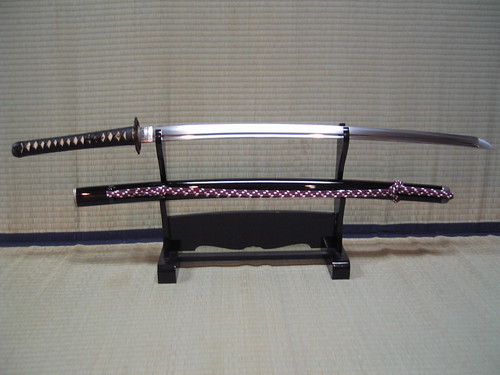 ". However, if we add sanzui ("three waters") to the left, it becomes tameru/tamaru "
". However, if we add sanzui ("three waters") to the left, it becomes tameru/tamaru " " "to collect, gather, store up". (the -eru forms are generally transitive verbs, the -aru forms intransitive.)
" "to collect, gather, store up". (the -eru forms are generally transitive verbs, the -aru forms intransitive.)The difference is crucial; both tomeru and tameru imply the absence of movement. Stopping, however, is the end of action. It may be immediately followed by a new action, but the flow is lost. There are two thoughts, to movements. No matter how quickly in succession they are performed, they are not one, but two, and that disconnect, even if only a fraction of a fraction of a second, is an opening to be exploited.
The water radical on the side of tameru implies flow, continuation. A river of course is flowing. But even a still lake, with a calm glass surface, stores up the water that flows in from tributaries and ground springs. Even if there is no particular movement at the moment it is observed, it is in a state of preparedness. Like a frozen stream, it has not stopped flowing, it's just pausing, to freeze and thaw, before continuing on.
A more modern analogy: run the battery in your cellphone down until it stops working. That's dead. Now plug in your cellphone, recharging the battery whilst using it. Hang up. Now make another call. The battery drains, charges, drains and charges.
This is hard to explain, especially in Japanese, where the word hayai means both fast (as in speed) and early (as in time), but it is important in making a distinction between merely moving quickly and repeatedly, and moving at the right time. If it is not yet time, you do not tomeru, you tameru. No matter how quickly you move, if you move too early, the enemy merely waits and counters. If you move too late, well your speed doesn't matter; you're already ready.
Just like the famous quote "The slow blade penetrates the shield", a well-timed strike is more effective than the fastest cut at the wrong moment.
In practice, there is no suki, no opening, in atomic movements, nor in the time between atomic movements when there is tame; storing, building, energizing, waiting. A single atomic movement from the moment the hand moves to draw to when the sword has completed its cut. And then...tame, patiently, sword pointed at the enemy...in another instant the sword is readied overhead and then strike quickly immediately or...tame; pressure, closing, tempting, holding, until the enemy moves to fight or flee and then strike, react in an instant no difference between his movement and yours, no opening in time or space no difference between movement and stillness and movement again.


